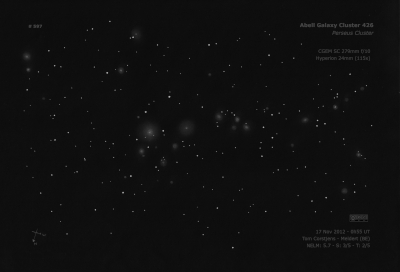Perseus A
Perseus A

William Herschel discovered NGC 1275 = H II-603 = h293 on 17 Oct 1786 (sweep 614) and recorded "pretty bright, stellar [nebula], or a pretty considerable star with a small, vF chevelure." William's position was 1.5' too far south. John Herschel made a single observation on 18 Sep 1828 (sweep 182) and measured an accurate position. NGC 1275 was observed by Lord Rosse's assistant Johnstone Stoney on 16 Dec 1848. He noted "A multitude of nebs. knots in the neighborhood, principally preceding; counted 15; many more."
Heinrich d'Arrest observed the cluster on 14 Feb 1863 (discovering NGC 1267, 1268, 1270, 1272, 1273 and 1278) and described NGC 1275 as a "nebula duplex", the second component being NGC 1278 about 3' NE, so d'Arrest was the first to observe NGC 1278. But he wasn't sure which of the two nebulae was NGC 1275 (H. II-603), so reported his observation of NGC 1275 as new and noted for NGC 1278: "II 603? [h]293?". John Herschel credited d'Arrest with the discovery of GC 675 (later NGC 1278), but Dreyer thought WH discovered NGC 1278 and he mistakenly assigned d'Arrest's discovery to NGC 1275. Steinicke agrees (personal e-mail) that Dreyer reversed the discovery credits and descriptions for NGC 1275 and NGC 1278 in the NGC and concludes:
NGC 1275 = II 603 = h 293 = GC 674, discovered by WH on 17 Oct 1786 and observed by d'Arrest on 14 Feb 1863. NGC 1278 = GC 675, discovered by d'Arrest on 14 Feb 1863 and independently by Bigourdan on 22 Oct 1884 (IC 1907).
NGC 1275 contains a Sy2 nucleus and is one of the 6 original galaxies studied by Seyfert in his seminal 1943 paper "Nuclear Emission in Spiral Nebulae". It is a powerful radio source (Perseus A)
100/150mm - 6" (10/24/87): extremely faint and small, round. Used a 6" mask on the 17.5".
200/250mm - 8" (1/1/84): faint but not difficult, small, slightly elongated, small bright core.
300/350mm - 13.1" (1/28/84): fairly bright, fairly small, small bright core.
400/500mm - 17.5" (10/24/87): fairly bright, fairly small, oval ~E-W, small bright core. NGC 1275 is a Seyfert galaxy and is the largest and brightest member of AGC 426. Surrounded by a swarm of faint galaxies in the core including NGC 1272 5.2' WSW, NGC 1273 4.4' WNW, NGC 1274 2.6' NW, NGC 1277 3.7' NNE, NGC 1278 3.3' NNE, NGC 1279 2.8' SE, NGC 1281 7.8' NNE.
600/800mm - 24" (2/13/18): at 375x; bright, fairly large, slightly elongated WNW-ESE, ~1.6'x1.3'. Divided into three distinct zones; sharply concentrated with a strong bright core, a prominent quasi-stellar nucleus and a halo that gradually fades out. Similar or slightly smaller in size to NGC 1272, but with a higher surface brightness core/nucleus. A mag 13.8 star is just off the NW side. A dozen members of AGC 426 were logged within 5' of NGC 1275! The closest is PGC 12441, 1.5' NE of center.
Notes by Steve Gottlieb